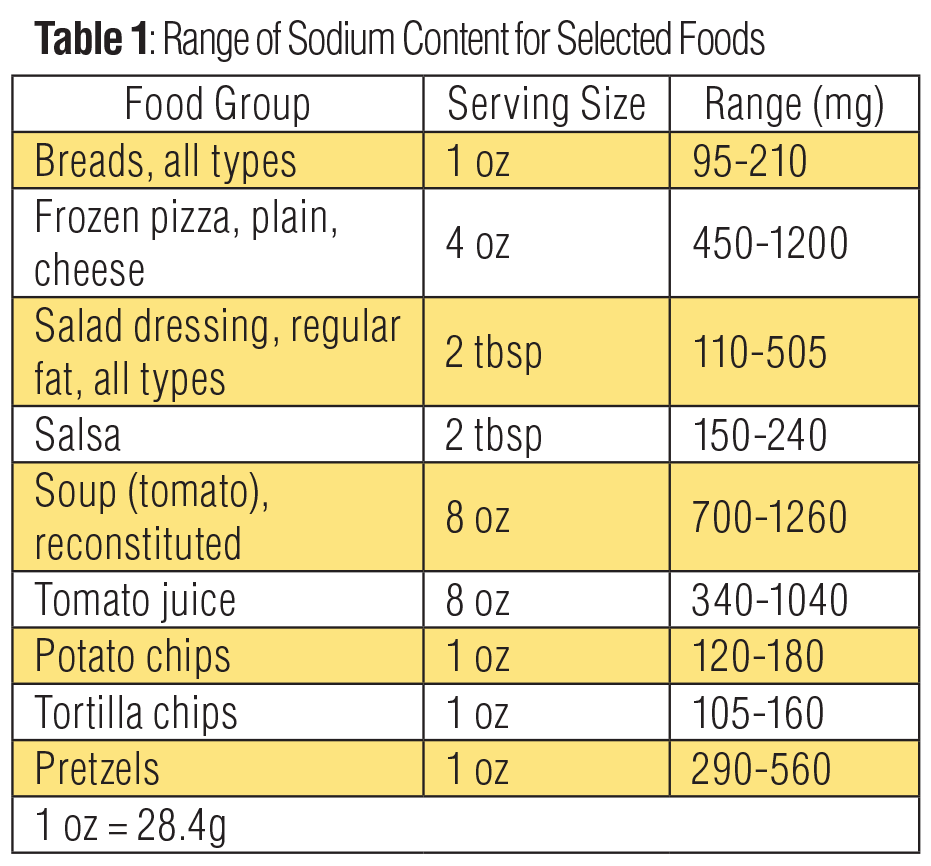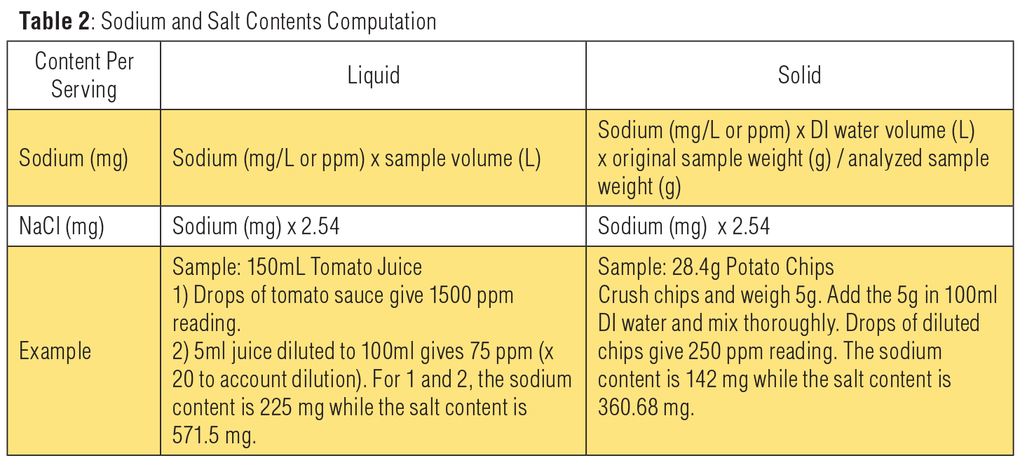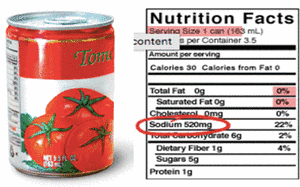

Foods contain varying amounts of salt (NaCl), which has 40% sodium. Determining the sodium content in foods accurately reduces the health risks associated with it. The American Heart Association1 recommends consumption of less than 1500 mg/day sodium for most American adults, which is the level with the greatest effect on blood pressure.
Most foods have sodium from dissolved salts, either naturally present or added in cooking or processing. Table salt known as sodium chloride (NaCl) is the most common source of sodium. It is made up of 40% sodium and 60% chloride and often used in processed and packaged foods as flavour enhancer or preservative. Other sources of sodium added in foods are monosodium glutamate (MSG), sodium nitrite, sodium saccharin, baking soda (sodium bicarbonate), and sodium benzoate.

(Source: Dietary Guidelines for Americans- http://health.gov/dietaryguidelines/dga2005/document/html/chapter8.htm)
The sodium content of food has implications on our health. Sodium is an essential mineral required in small amount by the body to control blood pressure and help the nerves and muscles to function properly. However, high sodium intake can cause health problems such as high blood pressure and cardiovascular diseases, which include heart, stroke, and blood vessel disease. Thus, knowing the sodium content in food and controlling the intake are of utmost important to keep diseases at bay.
To determine the sodium content in food samples, LAQUAtwin B-722 sodium ion meter offers rapid, simple, and easy measurement. This pocket meter has flat sodium sensor, which measures the sodium concentration in micro-volume samples, and result compensation setting (i.e., multiplication/known factor), which can be used to account sample preparation (e.g., dilution, blank reading) in results. Results can be expressed as parts per million (ppm) or mg/L.
Make sure that the meter is set to two (2) calibration points prior to calibration. Calibrate the meter according to manufacturer’s instructions using 150ppm and 2000ppm sodium ion standards.
Liquid samples such as soups, sauces, brines, beverages, etc., can be placed directly onto the sensor. Dilute the sample with distilled or deionized water, if the results exceeded the meter’s calibration or measurement range (e.g., 5ml sample dilute to 100ml using DI water).
Solid samples such as chips, cheese, ham etc., must be prepared to liberate the sodium. Mince or crush the sample in a blender. Weigh the crushed sample accurately, then add distilled or deionized water (e.g., 5 grams of sample in 100ml DI water). Mix the sample thoroughly. Place some drops of prepared sample onto the sensor and record the reading. To obtain accurate results, a uniform temperature should be maintained for the standard solutions and samples.
After measurement, clean the sensor with detergent and water (warm, if measured sample is oily). If the sensor is stained with sample residues, place a few drops of diluted bleach onto the sensor and leave for 5 to 30 mins. Rinse the sensor with water and blot dry with soft tissue. Condition the sensor by soaking it with 2000ppm sodium standard for 10 minutes to 1 hour prior to next use.
For high accuracy measurement, prepare ionic strength adjuster (ISA) solution containing 4M NH4Cl and 4M NH4OH. Add equal volume of ISA to all samples and standards (i.e., 2ml ISA in 100ml samples or standards)2.
Foods contain varying amounts of salt. For processed or packaged foods, sodium is listed as milligrams (mg) per serving on the nutrition information panel of the food packaging rather than salt. To compute the sodium and salt (NaCl) contents in food samples from the results, use the formulas in the table above.

The American Heart Association1 recommends consumption of less than 1,500 mg per day sodium for most American adults, which is the level with the greatest effect on blood pressure. This level does not apply to people who lose large amounts of sodium in sweat, such as competitive athletes, workers exposed to extreme heat stress, or to those directed otherwise by their healthcare provider.
To achieve the recommended level, check the nutrition information panel on food packaging when shopping and purchase the product which has the lowest sodium content after comparing different brands. Alternatively, test your food samples to determine the sodium content.

Figure 1: Nutrition Facts on the label of Tomato Juice (Source: Sodium Content, Medline Plus https://www.nlm.nih.gov/medlineplus/ency/imagepages/19703.htm)
REV 1.0, 6 DECEMBER 2015
Do you have any questions or requests? Use this form to contact our specialists.
Pocket Water Quality Meters

